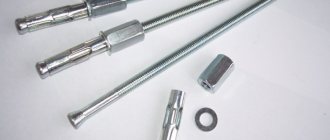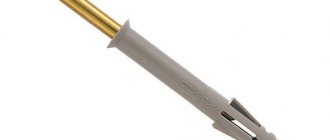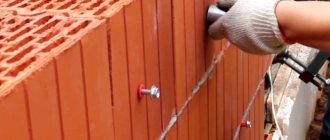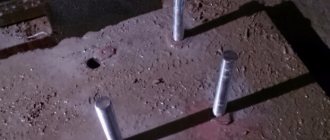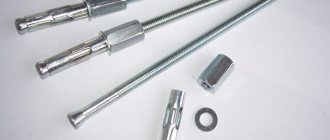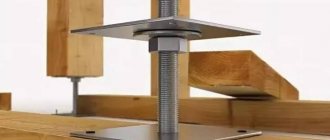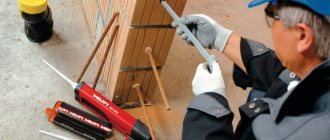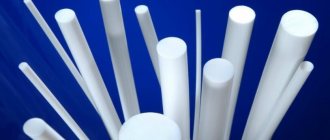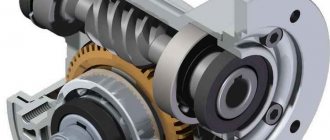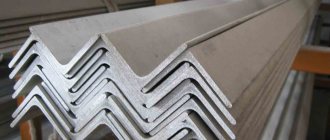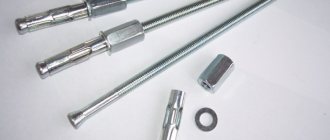Wedge anchor, unlike other types of anchors, has a peculiarity. It is used only for fastening thin materials or sheets (no more than 5 mm). The material to be fixed must be hard. It is perfect for working with stone, granite or concrete. It is often used when installing suspended ceilings.
Wedge anchor installation technique
- Holes are made in the fastening material and the part to be attached. The size of the holes must match the size of the anchor.
- Clean the finished holes from small stones and dust. Thorough cleaning of the surface is not necessary.
- Place the parts to be fastened so that the holes match.
- Place the wedge anchor into the finished hole and hammer it in so that the plane of the wedge fits completely. Its plane should coincide with the locking cap.
For a reliable fastening that will last a long time, it is necessary to install the fasteners correctly.
Application area
Such an effective fastening element as a wedge anchor is equally successfully used both in capital construction and when performing home repair work. The wedge anchor is applicable in situations where it is necessary to securely fasten objects of large size and significant weight to the surface of walls, floors and ceilings made of durable materials (concrete, brick, etc.).
The high reliability of wedge anchors is ensured not only by their design, but also by the material of their manufacture, which is galvanized steel, which has exceptional strength.
Considering the fact that such anchors are often used for installation of elevator shafts, cable routes, and highly loaded elements of staircase structures, very high demands are placed on their reliability and durability. It is also extremely important when using these fasteners to strictly follow the rules for their installation.
Among the varieties of such fastening elements, the ceiling wedge anchor occupies a special place. It is used to securely fix heavy and large chandeliers to the ceiling surface.
The ceiling wedge anchor consists of a steel rod, a stop cap and a wedge-shaped thrust
Technical features
When choosing a mount, you should pay attention to its length and diameter.
| Marking | Anchor and drill diameter, mm | Anchor length, mm | Thickness of the mounted part, mm | Hole depth, mm | Min. anchorage depth, mm | Tightening torque, Nm | Loads (compressed zone of concrete C20/25) | |
| Breakout, kN | Shear, kN | |||||||
| 6x40 | 6 | 40 | 2 | 35 | 25 | 4 | 1,0 | 2,0 |
| 6/15x65 | 6 | 65 | 15 | 45 | 35 | 7 | 1,7 | 2,5 |
| 6/50x100 | 6 | 100 | 50 | 45 | 35 | 7 | 1,7 | 2,5 |
| 8x50 | 8 | 52 | 2 | 45 | 30 | 15 | 3,3 | 3,4 |
| 8/10x72 | 8 | 72 | 10 | 60 | 45 | 15 | 3,6 | 5,7 |
| 8/30x92 | 8 | 92 | 30 | 60 | 45 | 15 | 3,6 | 5,7 |
| 8/50x112 | 8 | 112 | 50 | 60 | 45 | 15 | 3,6 | 5,7 |
| 8/85x147 | 8 | 147 | 85 | 60 | 45 | 15 | 3,6 | 5,7 |
| 10x60 | 10 | 62 | 3 | 50 | 30 | 30 | 3,5 | 3,8 |
| 10/10x92 | 10 | 92 | 10 | 75 | 60 | 35 | 6,3 | 10,3 |
| 10/20x102 | 10 | 102 | 20 | 75 | 60 | 35 | 6,3 | 10,3 |
| 10/30x112 | 10 | 112 | 30 | 75 | 60 | 35 | 6,3 | 10,3 |
| 10/50x132 | 10 | 132 | 50 | 75 | 60 | 35 | 6,3 | 10,3 |
| 10/80x162 | 10 | 162 | 80 | 75 | 60 | 35 | 6,3 | 10,3 |
| 12x85 | 12 | 85 | 3 | 75 | 55 | 50 | 6,5 | 9,6 |
| 12/5x103 | 12 | 103 | 5 | 90 | 70 | 50 | 7,9 | 13,1 |
| 12/20x118 | 12 | 118 | 20 | 90 | 70 | 50 | 7,9 | 13,1 |
| 12/30x128 | 12 | 128 | 30 | 90 | 70 | 50 | 7,9 | 13,1 |
| 12/50x148 | 12 | 148 | 50 | 90 | 70 | 50 | 7,9 | 13,1 |
| 12/65x163 | 12 | 163 | 65 | 90 | 70 | 50 | 7,9 | 13,1 |
| 12/80x178 | 12 | 178 | 80 | 90 | 70 | 50 | 7,9 | 13,1 |
| 12/155x253 | 12 | 253 | 155 | 90 | 70 | 50 | 6,4 | 6,4 |
| 16x90 | 16 | 90 | 3 | 80 | 60 | 100 | 9,9 | 21,8 |
| 16/5x123 | 16 | 123 | 5 | 110 | 85 | 120 | 16,7 | 25,1 |
| 16/20x138 | 16 | 138 | 20 | 110 | 85 | 120 | 16,7 | 25,1 |
| 16/50/168 | 16 | 168 | 50 | 110 | 85 | 120 | 16,7 | 25,1 |
| 16/60x178 | 16 | 178 | 60 | 110 | 85 | 120 | 16,7 | 25,1 |
| 16/95x213 | 16 | 213 | 95 | 110 | 85 | 120 | 10,0 | 10,0 |
| 20/20x170 | 20 | 170 | 20 | 135 | 110 | 240 | 19,8 | 27,7 |
| 20/70x220 | 20 | 220 | 70 | 135 | 110 | 240 | 19,8 | 27,7 |
| 20/130x280 | 20 | 280 | 130 | 135 | 110 | 240 | 19,8 | 27,7 |
The diameter determines the maximum permitted weight that can be hung on the anchor. The heavier the load that needs to be secured, the wider the diameter of the fastener should be. For light loads, a model with a diameter of 6 mm is suitable. For large loads, it is worth using a model with a diameter of 16 mm.
Depending on the thickness of the material being fixed, the length of the anchor varies. To attach a thin plate, you should choose an anchor from 30 mm. For thick sheets, it is better to take fasteners over 100 mm.
Recommendations for selection
When buying a wedge dowel, you need to take into account two parameters of the maximum loads: one is related to alignment, the other represents the maximum value that the bolt can withstand. It is also recommended to check the product certificate . Since dowels are often purchased for the installation of demanding heavy structures, the safety of people depends on their reliability and quality.
The workload can exceed the leveling limit by a maximum of 25%. If the concrete is strong enough, the anchor should be able to withstand high loads.
Analogs
Universal anchor sleeve
Although the bolt does not have a complete analogue in terms of design and functionality, on the construction market you can find a wide range of fasteners that allow you to connect structures made of different types of materials. The following types of parts are widely used in construction work:
- Universal anchor fasteners of standard design.
- Brass anchors , suitable for fixing various building components on concrete surfaces.
- Rod clamps . Their structure requires a large depth, and this must be taken into account when preparing the holes.
- Anchor elements for lightweight materials and structures . They allow you to work with plywood and plasterboard surfaces, securing various lightweight objects to them.
- Chemical fasteners , which use a metal pin and special glue. They are convenient because their installation does not require special physical strength. A capsule is installed in a pre-drilled hole. Inside it are glue and a hardening compound, separated by a partition. Later, a pin is inserted into the hole, which breaks the integrity of the shell and the separation membrane, resulting in the mixing and reaction of the two chemical components. The glue fills the cavity, and after it hardens, a strong bond is formed between the metal fastener and the walls of the hole.
Each fastener is designed for specific loads and connection methods. When selecting fasteners, these factors must be taken into account. The types of materials from which the connecting surfaces are made are also taken into account.
Wedge anchor B
Wedge anchor B
More details
Wedge anchor B
Wedge anchor B Wedge anchor B from the German manufacturer MKT is made by cold forming..
More details
Varieties
The strength and reliability of such fastening, moreover, combined with the speed of installation and relatively low cost, force manufacturers to seek new modifications of the wedge anchor. In addition, fasteners of this type are very popular in everyday life precisely because of their ease of installation, so in some cases new options are designed not so much for fastening strength as for convenience.
According to the material of manufacture
Based on the material used, wedge-type anchors are divided into 3 groups:
- made of structural steel - fasteners must be galvanized in order to ensure corrosion resistance of the material;
- Stainless steel models do not need galvanizing and have the same strength. However, due to the high cost, they are usually produced only to order. An anchor of this type can be used for chemical anchoring;
- models made of special alloys, including non-ferrous metals. Their characteristics are determined by the composition of the alloy.
Wedge anchor Rawlplug 16/30-150
By design differences
Based on structural differences, the following types are distinguished:
- with a washer – a wide washer ensures tight contact between the element being fixed and the surface. Typically used in cases where the object being secured is made of light, loose material;
- with a nut – a wedge anchor, the basic version, where the nut holds the element being fixed, and the spacer ensures fixation to the wall;
- with a ring - or with a hook. The design feature is designed for hanging objects: cable, rope, chandelier, water heater. The model with a hook allows you to remove the item if necessary;
- with impact spacer – fasteners for through installation. The difference is that here the wedging of the sleeve occurs not when the nut is tightened, but when the nail is driven into the anchor, through the material being fastened;
- ceiling - has an unusual design. Instead of a conical shank, there is a wedge-shaped spacer, the length of which is only slightly less than the body of the anchor. This model allows you to mount heavy volumetric chandeliers on the ceiling.
By additional properties
Manufacturers quite often offer new modifications, which are essentially variants of existing ones, but with some additional properties.
- For example, Mungo's anchor bolt, thanks to its four-leaf sleeve, is highly resistant to twisting.
- The FAZ anchor bolt from Fischer features a special profile and sleeve design that increases tensile strength by 38%. The bushing ensures a more uniform load distribution and has the ability to expand. Such fasteners can be used in tensile concrete.
- Double-spacer anchor - has 2 cylindrical spacer sleeves. When tightening the nut, two bushings are wedged out at once, which ensures a very strong fastening. This is an option for fixing in solid materials - stone, concrete, or similar heavy massive structures. For cellular concrete or limestone - any material that tends to crumble, fasteners cannot be used.
Simple installation of wedge anchors is shown in this video:
Wedge anchor B A4 (Stainless steel version)
Wedge anchor B A4 (Stainless steel version)
More details
Wedge anchor B A4 (Stainless steel version)
WEDGE Anchor B A4 (STAINLESS VERSION) Wedge anchor B A4 is made of austenitic stainless steel..
More details
Design characteristics
The wedge anchor is a carbon steel pin. There is a thread at one end of the pin, and a wedging mechanism at the other. It is represented by a special coupling, which, when expanded, allows the fastener to be maximally fixed in the base. Unlike similar anchor mechanisms, the wedge type of fastener does not have a protective “jacket”.
This design allows you not to monitor the drilling depth, which is sometimes completely impossible to do.
The wedge anchor consists of several interconnected parts
When installing heavy objects, the pressure that will act on the fastening element is always calculated. This is necessary in order to calculate the size and number of anchors for reliable fixation. All calculations are performed only using a special table by a person who has the necessary experience. Here it is worth considering the fact that the wedge anchor in most cases is taken a little more.
The size of the product is always stamped on the sleeve. To better understand that this is a wedge anchor and not a driven one, for example, the design is marked WAM. If there is no marking, then the diameter can be easily measured with a caliper. For example, let’s imagine the marking of a 15*12*100 anchor for concrete:
- 15 is an indicator of the body diameter. Judging by this criterion, a drill of the appropriate size is selected;
- 12 – stud size, which the wrench used must correspond to;
- 100 is the length of the anchor itself, which is selected depending on the thickness of the wall.
Wedge anchor B fvz
Wedge anchor B fvz
More details
Wedge anchor B fvz
WEDGE ANCHOR B FVZ Wedge anchor B FVZ is the optimal fastening element option for internal..
More details
The company's website presents all types of wedge anchors with their detailed descriptions. Ordering goods is very simple. All you need to do is fill out an application in your personal account or call the phone number listed on the website. Company managers will advise on all issues of interest.
What are anchors made of?
There are three main groups of such fasteners, which are made from:
- Structural carbon steel. This case involves subsequent galvanization, due to which the galvanized wedge anchor becomes resistant to corrosion. Protection layers can be applied either by hot-dip galvanizing or galvanizing;
- Stainless steel, which has the same strength characteristics as regular steel. In this case, galvanizing is not required, since they are not initially susceptible to corrosion. Such products are usually produced to specific order due to the rather high cost;
- Brass, as well as other alloys of non-ferrous metals suitable for these purposes. They are intended for special applications. The components that make up the alloy determine their performance characteristics.
Popular brands and prices
German and Finnish companies are recognized as the best in this area.
- Fischer is a German manufacturer. It produces all possible types of anchor bolts in a wide variety of modifications: with an enlarged washer, with a countersunk head, with a special sleeve design, and so on. Manufacturing of wedge anchors - from galvanized steel and stainless steel, packaging - from 4 to 50 pcs. The cost depends on the size and material of the wedge anchor: for example, the price of a stud anchor with an enlarged washer ranges from 44 rubles. per package up to 1262 RUR per 1 piece.
- Mungo is a Swiss company. Manufactures fastenings from structural and stainless steel, as well as from non-ferrous metals. Packaging includes from 25 to 100 pcs. The cost depends on the size and material - from 780 to 4607 per package.
- Sormat is a Finnish company that has, among other things, developed a design with 2 spacer bushings. Wedge-type anchors from Sormat are produced from electro-galvanized, hot-dip galvanized, stainless and even acid-resistant steel. The cost of products made from hot-dip galvanized steel is more affordable: from 26 to 408 rubles. per piece
- Tox is another German manufacturer that offers galvanized steel fasteners. The products are offered in small packaging - 2-5 pieces, cost - from 190 to 560 rubles.
- Hilti wedge-type anchors are also popular.
The wedge anchor is perhaps the most popular type of such fastener. The reason is its high strength, simplicity and, of course, relatively affordable cost.
The video below will tell you about installing a wedge anchor using SPIT FIX II as an example:
Anchor bolt with nut - how to fasten
Essentially, it is a stud with a nut and washer that is screwed into a coupling (threaded sleeve). Therefore, it can be called an anchor bolt with a nut or a stud anchor. We study in detail how to fasten anchor bolts with a nut ourselves and use them.
On one side, a nut and washer are screwed onto the stud, and on the other, there is a “wedge” in the form of a cone. In the wide part the wedge corresponds to the diameter of the coupling, in the narrow part it corresponds to the pin. The coupling on the wedge side has a notch and longitudinal slots.
Installation is quite simple, even a beginner can understand how to attach anchor bolts with a nut.
Mounting diagram
A hole for the coupling is drilled in the base and cleaned of dust. The part is hung on the anchor, inserted into the hole and hammered in with gentle blows of a hammer until it stops. Then tighten the nut a few turns.
Screwing onto the stud, the nut “unscrews” it from the coupling; as a result, the wedge expands the coupling along its entire length with slots.
Anchor bolts are made from galvanized steel. Used for concrete, stone, solid brick.
There is an “improved version” of such an anchor - a double-spacer one.
It has two movable couplings with slots, one of which fits into the other with a cone. When the nut is screwed in, the shank pushes one sleeve onto the other. The first one expands with a wedge cone and itself expands the middle coupling, forming two fastening belts.
